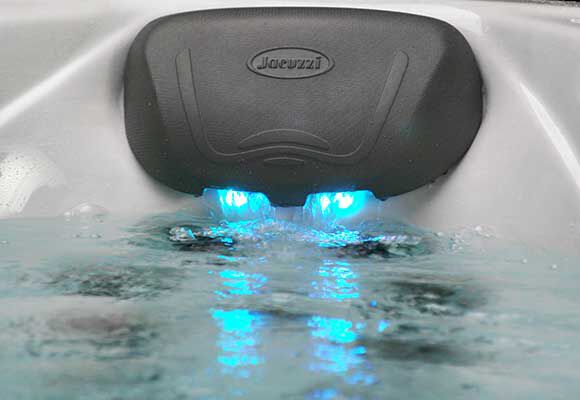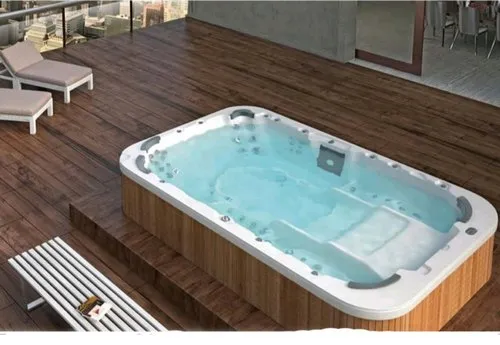All About In-Ground Hot Tubs
In-ground hot tubs are luxurious aquatic installations that offer a seamless blend of relaxation and aesthetics for homeowners seeking to enhance their outdoor living spaces. These permanent fixtures are embedded into the ground, creating a cohesive and sophisticated look that integrates harmoniously with the surrounding landscape. Unlike their above-ground counterparts, in-ground hot tubs provide a more immersive and customizable experience, often featuring advanced hydrotherapy options and design elements that cater to individual preferences. This article will delve into the myriad benefits, types, installation processes, maintenance requirements, and cost considerations associated with in-ground hot tubs, offering valuable insights for those contemplating this opulent addition to their homes.
Benefits of In-Ground Hot Tubs
The aesthetic appeal of in-ground hot tubs stands as a primary advantage, elevating the visual allure of any outdoor space. These aquatic havens seamlessly integrate with existing landscaping, creating a cohesive and sophisticated ambiance that enhances the overall property value. The flush installation allows for creative design possibilities, such as incorporating natural stone surrounds or lush greenery, resulting in a luxurious oasis that beckons relaxation and enjoyment.
Enhanced comfort and relaxation characterize the in-ground hot tub experience. The sunken design provides a more private and secluded environment, shielding users from external distractions and noise. The spacious nature of in-ground hot tubs accommodates various seating arrangements and depths, catering to diverse preferences and body types. This expansive design facilitates a more immersive hydrotherapy session, allowing users to fully submerge and benefit from the therapeutic effects of warm water and jet massage.
Durability and longevity are hallmarks of in-ground hot tubs. Constructed with high-quality materials and robust engineering, these installations withstand the test of time and environmental factors. The sturdy construction resists damage from harsh weather conditions, ensuring year-round enjoyment and minimal maintenance requirements. The permanent nature of in-ground hot tubs also contributes to their longevity, as they are less susceptible to wear and tear associated with movement or relocation.
Customization options abound with in-ground hot tubs, allowing homeowners to tailor every aspect to their specific desires. From unique shapes and sizes to an array of materials and finishes, the design possibilities are virtually limitless. Innovative features such as cascading waterfalls, chromotherapy lighting, and ergonomic seating can be seamlessly incorporated, creating a personalized sanctuary that caters to individual preferences and enhances the overall spa experience.
Types of In-Ground Hot Tubs

Concrete hot tubs represent a popular choice for those seeking ultimate customization and durability. These structures are built on-site, allowing for complete control over shape, size, and design elements. The versatility of concrete permits the incorporation of various finishes, such as tile, pebble, or plaster, enabling a perfect match with existing architectural styles. While concrete hot tubs require significant construction work and longer installation times, their longevity and ability to withstand heavy use make them an excellent investment for discerning homeowners.
Fiberglass hot tubs offer a more affordable and expedient installation option without compromising on quality. These pre-fabricated shells are manufactured off-site and delivered ready for installation, significantly reducing on-site construction time. Fiberglass hot tubs boast a smooth, non-porous surface that resists algae growth and simplifies maintenance. While customization options may be more limited compared to concrete, fiberglass hot tubs still offer a range of shapes, sizes, and colors to suit various preferences and outdoor aesthetics.
Acrylic hot tubs combine modern aesthetics with practical functionality, making them an increasingly popular choice for in-ground installations. These units feature a sleek, non-porous surface available in a wide array of colors and textures, allowing for seamless integration with contemporary outdoor designs. Acrylic hot tubs are known for their excellent heat retention properties and resistance to fading, ensuring long-lasting beauty and efficiency. However, it is important to note that acrylic surfaces may be more susceptible to scratches or damage, requiring careful maintenance to preserve their pristine appearance.
In-Ground Hot Tub Installation

The installation process for in-ground hot tubs begins with meticulous planning and design. Homeowners must carefully consider factors such as location, size, and desired features to ensure optimal placement and functionality. Consulting with a professional installer is crucial at this stage, as they can provide valuable insights on site preparation, local building codes, and potential challenges. Obtaining necessary permits and approvals is essential to avoid legal complications and ensure compliance with local regulations.
Excavation and foundation work form the cornerstone of a successful in-ground hot tub installation. The chosen area must be precisely excavated to accommodate the hot tub’s dimensions and plumbing requirements. A sturdy foundation, typically consisting of reinforced concrete, is crucial for long-term stability and preventing structural issues. Proper drainage systems must be incorporated to manage water runoff and prevent soil erosion around the installation site.
The installation and plumbing phase involves carefully placing the hot tub shell and connecting all necessary systems. This intricate process requires expert knowledge to ensure proper alignment, leveling, and sealing of the hot tub structure. Plumbing and electrical connections must be meticulously installed to support the filtration, heating, and jet systems. Waterproofing measures are implemented to prevent leaks and protect the surrounding soil from water damage.
Finishing touches transform the functional installation into a luxurious retreat. This stage may include adding decorative elements such as stone coping, tile work, or custom lighting features. Landscaping around the hot tub area enhances its visual appeal and creates a cohesive outdoor living space. Proper insulation is applied to maximize energy efficiency and reduce operating costs. The final result is a stunning in-ground hot tub that seamlessly blends with its surroundings while providing a haven for relaxation and enjoyment.
Maintenance & Care

Regular water testing and balancing are essential for maintaining optimal performance and ensuring a safe, hygienic environment in in-ground hot tubs. Homeowners must diligently monitor and adjust water chemistry parameters such as pH, alkalinity, and sanitizer levels. Utilizing appropriate chemicals for sanitization and pH adjustment helps prevent issues like algae growth, cloudy water, and skin irritation. Implementing a consistent testing schedule and maintaining proper chemical balance prolongs the life of the hot tub components and enhances the overall user experience.
Cleaning and filtration play a crucial role in preserving water quality and extending the lifespan of in-ground hot tubs. Regular cleaning of the filter system prevents the accumulation of debris and contaminants, ensuring efficient water circulation and filtration. Periodic draining and refilling of the hot tub allow for a thorough cleaning of the shell and removal of dissolved solids that accumulate over time. Implementing a routine maintenance schedule, including skimming the water surface and wiping down exposed surfaces, helps maintain a pristine and inviting environment.
Winterization is a critical consideration for in-ground hot tub owners in regions with freezing temperatures. Proper preparation for winter months prevents damage to the hot tub’s plumbing and components caused by freezing water. This process typically involves draining the water, blowing out the plumbing lines, and adding antifreeze to prevent residual water from freezing. Covering the hot tub with an insulated cover provides additional protection against harsh weather conditions and debris accumulation during the off-season.
Cost Considerations
Initial installation costs for in-ground hot tubs can vary significantly based on several factors:
1. Size and capacity
2. Materials used (concrete, fiberglass, or acrylic)
3. Custom features and accessories
4. Site preparation requirements
5. Local labor and material costs
The following table provides a general overview of cost ranges for different types of in-ground hot tubs:
| Type | Low-End Cost | High-End Cost |
|---|---|---|
| Concrete | $15,000 | $50,000+ |
| Fiberglass | $10,000 | $30,000 |
| Acrylic | $12,000 | $40,000 |
Ongoing maintenance costs must be factored into the overall budget for in-ground hot tubs. These expenses include:
– Water treatment chemicals
– Filter replacements
– Energy consumption for heating and circulation
– Periodic professional servicing
Factors affecting the overall cost of in-ground hot tubs extend beyond the initial installation. Labor costs can vary significantly depending on the complexity of the installation and local market rates. Material costs fluctuate based on quality, availability, and customization options chosen. Permitting fees and potential landscaping modifications contribute to the total investment. It is crucial for homeowners to obtain detailed quotes from reputable installers and factor in long-term operational costs when budgeting for an in-ground hot tub.
In conclusion, in-ground hot tubs offer a luxurious and customizable addition to any home, providing numerous benefits in terms of relaxation, aesthetics, and property value enhancement. The diverse range of options available allows homeowners to select the perfect hot tub that aligns with their preferences and budget. While the initial investment and ongoing maintenance requirements should be carefully considered, the long-term enjoyment and potential increase in property value make in-ground hot tubs an attractive option for those seeking to create a personal oasis in their outdoor living space. As with any significant home improvement project, thorough research and consultation with professionals are essential to ensure a successful and satisfying in-ground hot tub installation.

HIEN NGUYEN THI is the owner of topratedjacuzzi.com, a website that specializes in providing information and reviews on various types of jacuzzi hot tubs. With a deep passion for bathroom and spa-related products, Jessica has devoted a significant amount of time and effort to building topratedjacuzzi.com into a reliable resource for those seeking information on the best hot tub models on the market. Through her website, Jessica provides detailed and unbiased reviews of notable jacuzzi hot tub models, including their technical specifications, advantages, disadvantages, and recommendations for each product. Additionally, she shares personal experiences and helpful tips on selecting and using hot tubs, enabling readers to make well-informed purchasing decisions. With enthusiasm and extensive expertise, Jessica consistently updates topratedjacuzzi.com with the latest trends and technologies in the hot tub industry. Her goal is to become the trusted go-to destination for those who wish to research and choose the highest-quality jacuzzi hot tubs.







Great overview of in-ground hot tubs! I love how you highlighted the benefits of customization. Are there specific maintenance tips for ensuring the longevity of these tubs?
Informative article! I’m curious about the cost differences between different materials used for in-ground hot tubs. Can you provide more details on this?